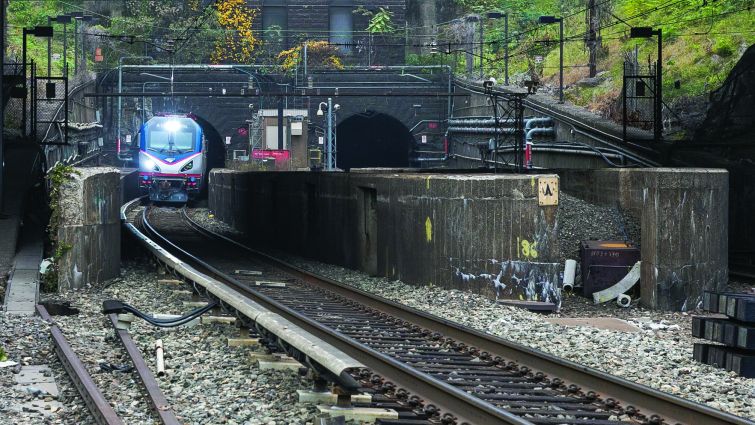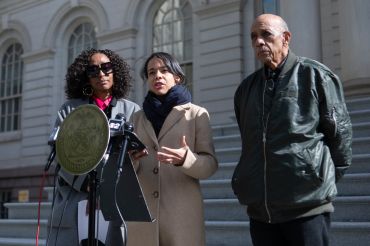Light at the End for the New York Region’s Gateway Project
Its completion would have a massive effect on the area's commercial real estate market and other economic sectors
By Patrick Sisson January 18, 2021 7:46 am
reprints
To move its economy forward beyond the pandemic, New York City first needs to figure out how to move commuters, workers and residents around its wider region. Figuring that out will very likely entail aid from a federal government suddenly more amenable to the city’s needs under soon-to-be Senate Majority Leader Chuck Schumer and President Joe Biden.
The diverging dramas around two of the region’s most important transportation systems — the long-hoped-for green light for the Gateway rail project under the Hudson River, and the budget crisis facing the subways, commuter rail and other parts of the Metropolitan Transportation Authority — highlight just how much infrastructure investment, or disinvestment, may impact any future recovery.
Even with the $4 billion included for the MTA in the most recent federal stimulus providing a lifeline that helps the agency avoid draconian 40 percent subway and rail service cuts, the system will still need to cut service on the Long Island Rail Road, hike fares this spring, and deal with $8 billion in debt expected through 2024.
Meanwhile, Gateway — which includes replacing the Portal Bridge over the Hackensack River, upgrading and fixing an existing tunnel between New Jersey and Penn Station and digging a new one under the Hudson, all of which aim to improve rail speed and capacity — has been engaged in as much pre-construction planning and work as possible. But a fair amount of procurement and pre-construction is still necessary. That includes federal approval of the project’s environmental impact statement, a key hold-up by the Trump administration.
With the administration of “Amtrak Joe” Biden poised to shift national infrastructure priorities, however, it seems the New York region will finally get a committed federal partner to build what’s long been called the nation’s most vital infrastructure project. And, with federal support for congestion pricing in Manhattan, another transit initiative that the Trump administration held up, the MTA may get a new funding stream to help speed up recovery from the significant ridership dips of 2020.
“President-elect Biden has prioritized infrastructure and the Hudson Tunnel project, building a new tunnel and fully rehabilitating the existing tunnel, specifically, which is good news,” said Stephen Sigmund, chief of public outreach for the Gateway Program Development Corporation, a nonprofit corporation overseeing the massive public works project. “And the right investment for any administration is to partner with us to build Gateway — providing tens of thousands of jobs, improving reliability and ultimately capacity, and protecting 20 percent of the nation’s GDP from a potential closure of a vital link to the nation’s economic heart.”
Craig Schulz, a spokesperson at Amtrak, currently estimates a $9.8 billion tab for the new tunnel, $1.8 billion for the rehab of the existing tunnel, and $13 billion for the entire Hudson Tunnel project overall.
The Gateway Program now has more support than it has had in years. The governors and congressional delegations of both New York and New Jersey back the project, though New York Gov. Andrew Cuomo in late 2020 pushed the release of a report questioning if building a new tunnel was necessary.
Carlo Scissura, president and CEO of the New York Building Congress, a trade group for the construction industry, believes this project, a “game-changer for the country,” is now definitely going to happen.
“Yes, and you can put that in capital and bold it,” he said. “This will be a signature project kicking off major infrastructure spending across the nation. We have a Senate majority leader from New York, a president who cares about Amtrak and rail across the country, and Democrats need to have big wins in the next two years. It’s time to get some big wins.”
Schumer said shortly after the November elections that there will be a “night and day” difference with the new administration regarding Gateway’s fate, after Trump took the project hostage to try to gain leverage over Schumer and other congressional Democrats to fund pet projects like the border wall — and it was the only project specifically named on Biden’s campaign website. The Biden-Harris transition team did not respond to a request for information about the status of Gateway.
Schumer also said he had a good conversation about Gateway around New Year’s with incoming U.S. Transportation Secretary Pete Buttigieg. “I explained to him that this has been a top priority for New York for more than a decade and that our future depends on it,” Schumer told reporters. “He was very receptive, and I was very optimistic.”
But, even if completion is a decade or so away, any concrete signal of federal support for Gateway right now would provide a needed boost for New York City’s real estate market, especially commercial property, which will rely on vibrant transit access to shuttle workers and tourists when they return to offices, stores and landmarks en masse.
Paimaan Lodhi, senior vice president of the Real Estate Board of New York, said that just the workforce needs met by rail travel under the Hudson River — 200,000 commuters on more than 400 trains daily pre-pandemic — make it a critical piece of infrastructure.
“Transit-oriented development has been premised on a functioning regional transportation system,” Lodhi said. “Over the past decade, a lot has been done and has been proposed to transform the West Side of Manhattan into an office district and modernize it to reflect a 21st-century reality: Hudson Yards, the just-opened Moynihan Train Hall, the Empire State Complex. The tunnel’s importance to our regional economy can’t be overstated.”
The rough cost breakdown of Gateway would see the federal government back half of it, with New York and New Jersey footing the rest of the bill. But can state governments facing extreme economic headwinds and pandemic-induced budgets take on billion-dollar debts right now?
Yonah Freemark, a researcher at the Urban Institute, said that since Gateway is a project of national importance, the federal government should pay for the project. In London, the monumental Crossrail project, a $25 billion, new east-west subway line, will be backed largely by the U.K. government (in part via a property development tax). But without that federal backing and rigorous tax planning, Gateway could splutter.
“I’m very concerned,” Freemark said. “For state agencies and the Port Authority [of New York and New Jersey], currently losing billions of dollars right now, it’s not clear this is a good financial plan. It needs to be shored up with a new source of revenue, or there’ll be an increasing problem with debt.”
There hasn’t been a tunnel dug underneath the Hudson River since the Lincoln Tunnel, a nearly 90-year wait that’s been prolonged due to years of bickering over funding involving multiple gubernatorial and presidential administrations. In August, the Port Authority estimated that the cost of the project had gone up nearly a million dollars for each day of delay since a proposal was submitted in 2019.
The last major attempt at serious repairs, the ARC project (Access to the Region’s Core), was killed in 2010 when then-New Jersey Gov. Chris Christie backed out of his state’s commitment, fearing rising costs. New Jersey reappropriated its share of the funding to highways.
Getting Gateway moving, despite the size and complexity of the project, may actually be a more immediate fix than rescuing the Metropolitan Transportation Authority, which continues to face a financial reckoning. While all of the nation’s mass transit systems have felt the sting of reduced ridership during COVID, the MTA and its subways, in particular, are uniquely positioned to suffer from such a drop-off.
In a typical year, fares cover more than half of the agency’s costs. So, while the $4.1 billion the agency received from the CARES Act and the $4 billion included in the last stimulus are substantial, the agency collected $6.4 billion in fares in 2019 alone. Until ridership returns to something approaching normal — as of January, the system sees roughly a third of its usual 5.5 million daily riders — the MTA will still struggle to overcome a projected multibillion-dollar shortfall through 2021.
If the agency makes drastic cuts, REBNY’s Lodhi said, it will slow down any economic recovery. “Our city can’t operate without a functioning transit system.”
Freemark thinks that one of the first things the Biden administration will do is permit necessary moves for congestion pricing, a system that would toll most noncommercial vehicles operating south of 60th Street in Manhattan to fund MTA capital improvement plans.
Until that funding begins to roll in, which is only possible after lengthy installation of tolling infrastructure and contentious debates over regulations, the MTA is still stuck with revenues far below average. And for congestion pricing to truly make a difference — pre-pandemic studies estimated $1 billion in annual revenue — it would require a vigorous office market and commuter traffic to return.
“Many of the issues the MTA is facing will be incredibly dependent on the recovery of the economy and office market, and we can’t know when that will happen,” Freemark said. “The MTA is appropriately being quite conservative about the return of ridership over time.”
The intertwined nature of transportation infrastructure investment and the city’s economic activity only highlights the continuing cost of poor planning and past political debates over regional infrastructure.
Alon Levy, a transportation analyst, said the Gateway’s long history reinforces local, and national, failures around infrastructure, namely those involving controlling prices; adapting best practices around the world; and thinking long term or strategically about such significant multibillion-dollar investments.
But, better to invest now than later. Sigmund of the Gateway Program Development Corporation said that the digging of the tunnel will provide 73,000 jobs alone and provide an immediate stimulus to the New York economy.
“Obviously, everyone is in a tight revenue spot, but this isn’t a project for the moment,” Sigmund said. “New York is going to come back and better, and it always has through past downturns.”


